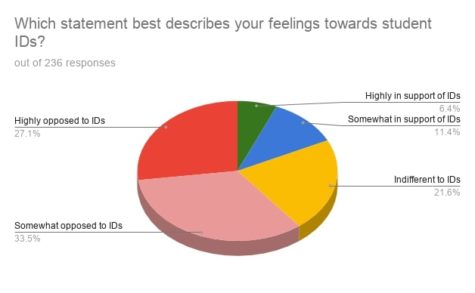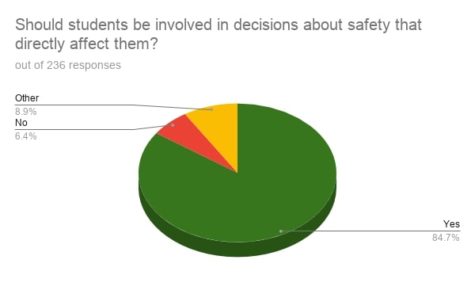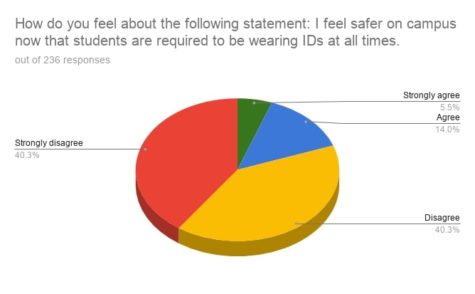BCA Safety and Student IDs
November 4, 2019
Student IDs have been issued to BCA students for many years. However, starting this year, all students are required to visibly display their IDs at all times while on campus―and there are consequences for non-compliance.
Contrary to what many believe, this is not a new rule. According to the BCA Student Handbook, the policy has always been that “Students are expected to have ID badges on their person at all times. Failure to do so will result in disciplinary action…For purposes of school security, the Board of Education requires all students to visually display district-issued identification cards at all times while in school.” This is, however, the first time in many years that the rule is being enforced.
According to the National Center for Education Statistics, 16.5% of high schools required students to wear IDs during the 2015-2016 school year. However, those statistics are likely to have changed with recent tragedies such as the Parkland, Florida school shooting, which occurred in February 2018 and resulted in the deaths of 17 people.
According to an article by NBC San Diego, in the 2015-2016 school year, there were 66 incidents of gunfire in schools, and in 2018, the number reached a horrific 103. School safety is at the forefront of people’s minds, and schools are making an effort to decrease the likeliness of an incident happening in their own communities.
The Academy Chronicle conducted a survey to find out what BCA students thought about the enforcement of the ID policy. Of the 236 students who were polled, approximately 60% are opposed to the ID policy, 20% support it, and the remaining 20% are indifferent.
Another question found that only around 20% of the student body feels safer on campus because of the enforcement of this policy. One student commented that the policy was “a waste of time, money, and enforcement for a system that can so easily be tricked by any willing individual.”
Students have both positive and negative comments on the policy. Roughly 85% of the students who were polled believe that the student body should have a say in policies that affect them. Another 10% generally believe that administration should create the final protocol, but the decisions should also be communicated explicitly to students so that they clearly understand the purpose and objective for it. Many also believe that student perspectives would be beneficial for small-picture issues, like the exact execution of a plan, but ultimately the state and the board should have the authority to finalize the decisions.
Not all students are against the policy. One student says, “We should’ve had this policy before.” This student, along with others, have growing concerns for the safety of the campus. They believe that the policy is “the first step towards a safer community” and is “very necessary in today’s climate.” Some of these students share the belief that IDs are not as bothersome as others make them out to be, and if students fully understood the rationale behind it, the policy would be more widely accepted.
Additionally, some students did say that they support the policy, but expressed concerns that it was not being enforced in the appropriate manner. These students noticed peers wearing their IDs from a previous school year or even a friend’s old ID and felt that the entire ID plan was rendered ineffective with these violations going unnoticed.
Another suggestion that students believe would increase school security is a check-in system in which students must scan their IDs to enter the building. This would be a preemptive solution which prohibits unwelcome visitors from entering in the first place.
Some students say that the IDs cannot properly secure the school on their own, but according to BCA’s Principal Mr. Russell Davis, the District is looking to implement additional safety initiatives as well. These policies may not affect a student’s day to day activities like the IDs, but they are equally important.
School Safety Officer Aret Yesiltepe loves the new policies and believes they are of tremendous help to the security team. For example, if there is a new teacher, the security guards can take a closer look at their ID to make sure they are authorized to be in the school without being sent into a panic over an unfamiliar face.
He has also found that BCA has more visitors, such as alumni and parents, compared to other schools he has been in, which prompted another rule. No matter who the person is or how brief their visit may be, the school requires them to sign in. Beyond that, their intentions in the school must be verified by the person they have come to visit, and they must be monitored while in the building so they do not stray from their intended destination.
Officer Yesiltepe mentioned that many other schools across the state require students to carry IDs, so this is far from a radical policy. One thing that differs from BCA’s approach is that they provide a second copy free of charge in case a student loses the original. This makes it more student friendly and gives them room for error—although an anonymous student still finds it to be “oddly aggressive towards people who are forgetful.”
Ms. Stott, a teacher in the biology department, supported this policy for an unexpected reason. She believes that “it is more of an administrative issue than a direct safety issue.” By wearing IDs, Ms. Stott can identify who is or is not a visitor and give them directions if they seem to be lost. As Officer Yesiltepe mentioned, there are many visitors at BCA; whether there is a parent in the parking lot trying to find the main office, or a visiting student trying to find the location of an event, students and staff can assist. Ms. Stott says that does not feel unsafe on BCA’s campus, yet remains a supporter of this policy.
Nevertheless, student IDs are still a safety protocol and were suggested by top safety officials. When asked if there was a specific event that led to the enforcement of the policy, Mr. Davis said, “The use of IDs was recommended by police officials at the County and State level. I don’t think it was one particular incident but rather a number of situations…that prompted the new policy…” He further explained that “IDs were just one aspect of a larger plan to keep both students and staff safe.”
When evaluating the new safety policy, students should take into consideration the extra layers of security that have been implemented, such as escorting visitors to their desired location and back and calling teachers before allowing anyone to visit them. School safety officials such as Officer Yesiltepe say this helps keep track of who is inside the building and prevents them from wandering off to a different location. Although some students may believe the purpose of IDs is to prevent access to the building, Mr. Davis explains that IDs actually serve another purpose, which is to “quickly identify whether someone belongs on campus.”
Sources:
https://nces.ed.gov/fastfacts/display.asp?id=334
https://www.nbcnews.com/news/us-news/police-respond-shooting-parkland-florida-high-school-n848101




